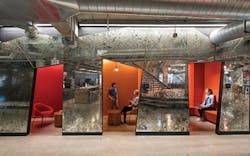In a time when disruption and “move fast, break things” are de rigueur, what does it take to be an actual pioneer? Finance giant Capital One is proving it is possible, having led the digital revolution and approaching its business as a technology innovator, not a bank. The company has also firmly planted a foot in the design world, with a Workplace Solutions team that applies Capital One’s innovative take on business to its network of campuses. ASID spoke with Michelle Cleverdon, Capital One workplace strategist, to gain insight into the company’s unique approach.
ASID: How did Capital One’s design journey begin?
Michelle Cleverdon: From a Workplace Solutions perspective, the big pivot for us came in about 2011. We’ve always been a data-driven company with an entrepreneurial spirit, and we made the decision to say we’re becoming a tech company that specializes in finance. We wanted to make a difference and inspire the company to think differently, not only about their work and how they do it, but also their work environment. As a result, it changed who we were hiring and pushed us to invest more in design. Capital One has always invested in our people and the space they work in, but we knew that with the digital transformation, we had to approach our workplace differently.
ASID: What was the process for developing these newly designed spaces?
MC: We started small. We partnered internally with some of our groups that are more focused on innovation and worked with them and some incredibly talented design firms to prototype designs and determine what this change really meant. As a result of those smaller projects, we were able to figure out how to scale that to the rest of the organization and our portfolio. Then it started growing like wildfire; people from different groups would see these new spaces and come back saying, “I want this!” Our early adopters pushed our thinking, too, and we learned a lot along the way.
The Workplace Solutions team took a truly comprehensive look at what our associates needed to give our design partners the best idea of how to make a new space work. It was (and still is) important that we provided designers with as much information as possible so they can start on chapter two or three rather than the prologue. They already have a sense of who we are when they begin the project.
ASID: What are the most important elements of workplace design for Capital One?
MC: We’re here to create holistic, integrated, inclusive environments that provide a space where everyone can thrive and do their best work. We want the people working in these spaces to be happy and feel like they’re part of the bigger picture that we all work toward and believe in.
From an overall space standpoint, we look at collaboration on a spectrum from peer-to-peer to associate and all the way up to teaming. Collaboration also has a full cycle: you work with your teammates but you also need a moment to work independently to produce. So we ensure that our spaces have room for both collaboration and individual work. We design our spaces around choice, flexibility, and variety. Flexibility is not only how people use space but also how spaces can adapt. Because of that, we try and make spaces as multipurpose as we can.
Another key element is fostering an inspired, culture-driven, inclusive atmosphere, because everyone at Capital One is working toward the same goal. The design encapsulates the principles of our culture: being approachable and authentic and being challengers is in our company DNA, so we incorporate this attitude into the designs.
ASID: What is on the horizon for the Workplace Solutions team?
MC: Industry knowledge is really important to us, so we want to make sure that we’re sharing our experiences with the community. Looking ahead to 2018, we want to step up our approach to wellness. It’s always played a major role in our strategy, but we’re examining it holistically: How can we better accommodate your physical, emotional, and spiritual well-being? Something I’m particularly interested in as well is experiential design. We have the opportunity to integrate our stories, whether that be brand, our associates, or even to better the voice of our customers, in a more interesting way. This applies to digital, physical or architectural, or in combinations to create a multilayered approach.
ASID: How has workplace design impacted corporate culture?
MC: We do a lot of measuring to assess the performance of our spaces, such as employee feedback sessions, focus groups, usability studies for new spaces, and pre- and post-occupancy research and observation studies. I notice the biggest difference as I interact with the people around me every day. Before we started this initiative, you wouldn’t hear people remark much on the space; it was static and lackluster. Now, you’ll overhear people talking about how happy or impressed they are with some element of the space, or they’ll be posting a picture of a cool piece of art or architectural detail on social media. I see people bringing in their families or friends to show them around or stay to enjoy our on-site amenities because they’re proud of where they work. If you think about how innovation occurs, you need visionary leadership and trust to move forward, of course, but space is a big component of that too. It’s a physical representation of how invested you are in your company and its collective purpose, and it can really serve as a megaphone to broadcast the company culture. The power of place excites me most about what we do.
